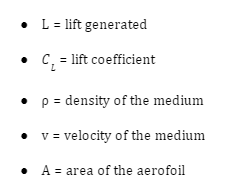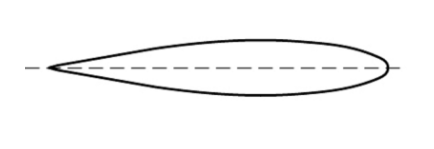Introduction
The question of how aeroplanes stay up in the air has a very interesting answer. The physics behind it isn’t so complicated and can be easily understood if you understand what aerofoils are.
To understand aerofoils, one must first understand what forces aid in keeping aeroplanes up. There are four such forces known as drag, thrust, weight, and lift. The last one of these is what allows aeroplanes to take off into the air and thus, is the most interesting to understanding.
Lift is generated when an object travels through air and “pushes” its surrounding molecules to make way for itself. This “pushing” action causes the object to experience aerodynamic force. Physically, this aerodynamic force may be resolved into two components, which are termed drag, and lift. These components act exactly as their name describes, i.e., the effect of lift is to “lift” up the object, while the effect of drag is to slow down its motion. From this basic introduction, it is easy to see that an object can only take off and fly when the lift is greater than the drag. Aerofoils make this balance possible. Let us discuss in detail.
What is Aerofoil?
The word aerofoil does not refer to a single object. Instead, it refers to the cross-sections of special kinds of shapes which can generate the most favourable ratio between lift and drag forces. A few common types of aerofoils are shown in the image below and you can see how these shapes aren’t straight.

Aerofoil examples
The idea behind aerofoils is to maximize efficiency. It is not possible for any object to travel without experiencing drag force. However, aerofoils are designed so that they maximize lift while minimizing drag. What’s interesting, though, is the fact that aerofoils aren’t necessary for aeroplanes to fly. An aeroplane with flat plate wings can also theoretically take off, but the efficiency would be extremely low. This is what makes aerofoils so useful while designing aeroplanes.
Aerofoil Terminology
There are a few important terms, the understanding of which, is necessary for understanding the working of an aerofoil. The image below shows these terms and they are summarized below:

Aerofoil terminologies
- Leading edge: Just as the name suggests, the leading edge is in the “lead”. That is, it collides with the air molecules first.
- Trailing edge: This is the “tail” of the aerofoil and is the rear-most part.
- Chord line: When we draw a straight line from the leading to the trailing edge, we get the chord line. Its length is known the chord and depending upon the shape of the aerofoil, it can even lie outside the aerofoil.
- Angle of attack: When an aerofoil moves through the air, it “attacks” or “cuts” through air particles. The angle of attack is the angle made by the direction of the wind and the chord line. Take a look at the diagram for a better understanding.
- Upper surface: While travelling through air, the upper portion of the aerofoil, experiences lower pressure and the air above it travels at a higher velocity. Thus surface is known as the upper or suction surface.
- Lower surface: The pressure underneath the aerofoil is higher and thus, the bottom part of the aerofoil marks the lower or pressure surface.
- Camber line: This line demarks the “center” of the aerofoil and divides it into upper and lower halves. The camber line may be curved depending on the aerofoil’s shapes and its distance from the chord line is a parameter known as the camber.
How does Aerofoil produce lift?

Air flow around aerofoil
The image above shows an aerofoil moving through air and the arrows represent the flow of air. You will notice that air particles tend to follow the same path as the shape of the aerofoil. When aerofoils have a curved shape, the air molecules follow that curved path as well.
When the angle of attack is properly adjusted, the curved flow of the air makes it so that upon collision with the aerofoil, a larger number of air molecules go underneath the aerofoil than above it. This naturally creates a pressure difference between the upper and lower surfaces of the aerofoil, which makes the air below it push it upwards. This pushing force is what we call lift. The curved shape of the aerofoil also minimizes the drag, allowing aerofoils to achieve take off very easily.
Lift Coefficient
The lift coefficient relates the lift generated by the aerofoil to its area, as well as the velocity and density of the medium the aerofoil is travelling in. It is a dimensionless quantity which is larger when lift achieved is larger, and smaller otherwise.
The following equation sets up the lift coefficient.

Here:

We can derive lift coefficient from it and arrive at the following result.

Where q is the pressure of the fluid. The value of lift coefficient is derived experimentally and it summarizes exactly how the lift generated will depend on various factors.
Types of Aerofoils
We classify aerofoils into two categories based on geometry:
- Symmetrical Aerofoil

A symmetrical aerofoil
When the upper and lower surfaces of the aerofoil are congruent, it is termed as a symmetrical aerofoil. In such aerofoils, the chord line and the camber line coincide and perfectly divide the aerofoil into equal halves. They are generally used in helicopter blades and produce no lift if the angle of attack is zero.
- Non-symmetrical Aerofoil

A symmetrical aerofoil
As can be seen from the image above, non-symmetrical aerofoils have unequal upper and lower halves. The chord and camber lines are separated from each other and the latter is curved. While such aerofoils can even work with zero angle of attack, they aren’t very economical.
Summary
Lift, thrust, drag, and weight are important forces which come into play when aeroplanes fly. Lift and drag are connected to each other and in fact, are components of the aerodynamic force that an object experiences while moving through a gluid. Lift pushes the object up, and drag slows it down. Aerofoils refers to cross-sections of shapes that are designed to maximize lift and minimize drag. This happens because aerofoils push a larger amount of air beneath them, leading to a pressure difference. They are classified into symmetrical and non-symmetrical types depending on geometry, and non-symmetrical aerofoils are more efficient but less economical.
Frequently Asked Questions
1. Who designed and invented aerofoils?
Max Munk, a German mathematician, first envisioned aerofoils. Later, Hermann Glauert made improvements to their design in the 1920s.
2. Where are aerofoils used?
Aerofoils are used in the wings and rotors of all aircrafts and helicopters. Wind turbines also have an aerofoil shape and the aeronautics sector makes the most use of aerofoils.
3. What is the significance of the four forces that aid an aircraft to fly?
An aircraft’s weight pushes it downwards, while thrust moves it forward. Drag slows it down and lift pushes it upwards. All four forces must be considered when studying aircraft.
4. At what angle of attack is the maximum lift force generated?
The maximum lift force is generated at the critical or stall angle of attack. This angle varies based on various factors, but for most aerofoils, it is between 15-20 degrees.
5. Is the concept of aerofoils applicable in liquids too?
Yes. The principles remain similar when an object moves through a liquid, but in that case, the term hydrofoil is used instead of aerofoil.
 Mission Statement
Mission Statement
“Empower every student to achieve full potential”
88Guru has been established with the social objective of making quality video-based learning material available to all Indian students. Technology, Connectivity and Social Media are rapidly changing the world of Education and we wish to lead the transformation of the tuition industry in India.
88Guru is the perfect complement to the current tuition model. 88Guru creates a wonderful opportunity for children and parents to bond while engaging in a valuable learning activity. It also provides the complete curriculum at your fingertips for those moments when you need some help at short notice. We believe that this mode of tuition could be transformational, adding hours to a child's day while providing complete control over the learning process.
Every course is taught by the best teachers from India's top schools and conducted in an engaging manner to keep students involved. The e-learning process consists of video-based instructions, computer-graded assignments, and a dashboard which allows the student and parent to track progress.


